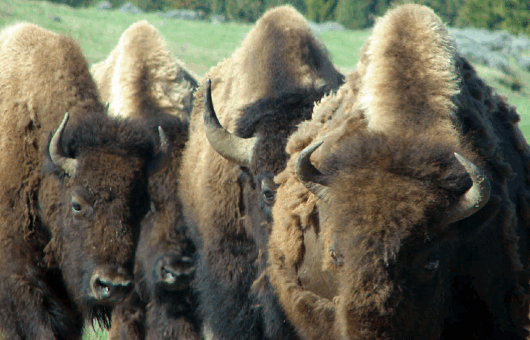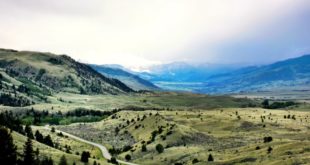The arrangement makes use of the Royal Teton Ranch (RTR) as a gateway for bison to move between the northern boundary of Yellowstone National Park and Yankee Jim Canyon, at the northern end of the Gardiner Basin. In the spring of 2008, an agreement was reached between the State of Montana and the Church Universal and Triumphant which removed cattle from RTR for a period of 30 years, clearing the way for bison to move onto and across RTR property and onto national forest lands covered under Step 2 of the Interagency Bison Management Plan (IBMP) to conserve a viable, wild bison population while protecting Montana’s brucellosis-free status.
Early Tuesday afternoon, a group of 23 mixed bison was hazed into a fenced pasture at the Stephens Creek capture facility northwest of Gardiner, Montana, inside the park boundary. Once a large enough group of bison is collected, they will be tested for exposure to brucellosis. A mixed group of 25 bison will be selected from those that test seronegative for exposure to brucellosis. The animals will be marked and fitted with monitoring devices, and then released and moved to Gallatin National Forest land where they will be allowed to remain until spring. The bison remaining at Stephens Creek will be released back into the park.
The Record of Decision negotiated by the IBMP partners directs the agencies to evaluate the most effective means to enforce the State of Montana restrictions regarding bison distribution. Once the agencies have determined they have gained significant experience with this small group, in subsequent years they will allow first up to 50 and ultimately as many as 100 untested bison on the same landscape. The agencies may adjust these numbers based on this intermediate phase of the management plan.
For safety reasons, the area around the Stephens Creek facility is closed to the public when capturing, holding, and releasing bison. A map and information on the closure is available for public review during normal business hours at the Chief Ranger’s Office and the Albright Visitor Center.
This is the eleventh winter the IBMP has been used to guide brucellosis risk management actions.
The cooperating agencies operating under the IBMP are the National Park Service, the U.S. Forest Service, the Animal and Plant Health Inspection Service, the Montana Department of Livestock, the Montana Department of Fish, Wildlife and Parks, the InterTribal Buffalo Council, the Confederated Salish Kootenai Tribes, and the Nez Perce Tribe. More information on the IBMP can be found at http://ibmp.info/.
The Buffalo Field Campaign, a critic of IBMP practices, came out against the new management plan.
“This RTR scheme increases harm and disrespect to buffalo, not tolerance,” said Stephany Seay, a spokesperson with Buffalo Field Campaign. “It’s a new phase in how Yellowstone and Montana aim to treat wild bison like livestock.”
The Campaign correctly points out there has never been a documented case of brucellosis being transmitted from bison to cattle; the much more likely culprit, according to scientists, is elk. Because science doesn’t support these practices, they put bison under unnecessary stress.
“These buffalo will suffer the torments of hazing, capture, squeeze chutes and blood tests,” said Seay. “Of the approximately sixty to be captured, the chosen twenty-five buffalo will be forced to wear ear tags, radio collars, and – for pregnant females – vaginal telemetry devices. They will then be pushed into this ill-thought Corridor to Nowhere surrounded by electric fencing and cattle guards, while the rest are forced back into Yellowstone.”
We’ve also set up a free Twitter account so you can receive updates on the device of your choice.
 Yellowstone Insider Your Complete Guide to America's First National Park
Yellowstone Insider Your Complete Guide to America's First National Park





